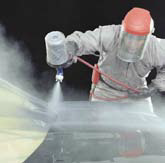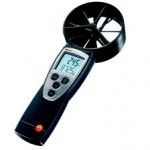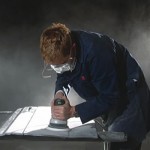Vehicle paint sprayers are 80 times more likely to get asthma than the average worker. 1 in 10 of workers in bodyshops who get asthma from isocyanates are not sprayers.
Myth 1: “We use water-based /UV-cured paints, which are isocyanate-free. Anyway, isocyanates are going to be banned”
Truth 1: Almost all bodyshops use isocyanate-containing paints. Rumours that isocyanate-containing paints will be banned are incorrect. Isocyanates will continue to be used in some primers and base coats as well as UV-cured coatings and some water-based paints.
Remember, ‘Water-based’ does not mean ‘isocyanate-free’. And almost all top coats contain isocyanates.
Myth 2: “Modern guns don’t mist like the old ones so are much safer”
Truth 2: All modern guns are designed to produce less mist. But that assumes that they are set up as the manufacturer intended – and that still doesn’t make them safe. Modern guns still produces average levels of isocyanate over 1000 ug/m3 (over 50 times the workplace exposure value, which itself is not a safe value).
Myth 3: “It won’t affect me, I wear a mask”
Truth 3: Wearing a respirator is essential when using isocyanate-containing paints but you need to ensure:
It is the right type – only air-fed breathing apparatus is suitable for isocyanate spraying (filtering face masks are not acceptable); and
It is used at all times when exposure is possible – many sprayers believe it is safe to remove their mask as soon as they have finished spraying but the air still contains large quantities of paint mist that is invisible to the naked eye.
Myth 4: “I work in a booth so the air is kept clear”
Truth 4: If you work in a modern purpose built spray booth with large quantities of filtered air flowing past it is easy to believe that all the overspray is instantly carried away leaving the air safe to breath as soon as spraying is finished. This is a dangerous misconception. In fact, spray booths typically take between one to five minutes to clear. During this time, it is essential that you keep wearing your air-fed mask and no unprotected person enters the booth.
Spray rooms are much cruder devices than booths and are much slower to clear (it can take half an hour or more). The levels of isocyanate in spray spaces have been measured at levels up to 300 times the workplace exposure limit. If you want to carry on using a spray room you need to make sure it works as safely and efficiently as possible.
Anyone using a spray booth or room needs to know what the clearance time is. Booths and spray rooms only work effectively if they are kept maintained.
Myth 5: “I can go in the booth/spray room as soon as the mist has cleared”
Truth 5: One in 10 of people who get asthma from isocyanates in bodyshops are not sprayers. This means they are getting exposed some other way. One of those ways is entering a spraybooth/spray room before the entire fine, invisible mist has cleared. Even the most efficient booths take over a minute to clear after spraying has finished. Some take significantly longer. A spray room can take up to half an hour to clear.
Anyone entering a spray booth or spray room needs to know what the clearance time.
Myth 6: “It’s only a touch-up job, I can do that in the workshop”
Truth 6: One in 10 of people who get asthma from isocyanates in bodyshops are not sprayers. This means they are getting exposed some other way. One of those ways is by people spraying outside the spray booth. Perhaps it is because the job is short or the booth is already in use. But the fact is that large quantities of paint mist are spread throughout the workshop endangering the health of anyone in the vicinity
Myth 7: “Isocyanates cause cancer but so does everything else these days.”
Truth 7: There is no known case of isocyanate used in paints causing cancer! But they are the biggest cause of occupational asthma in Australia. To confuse the two may cause someone to overlook the classic early symptoms of asthma – wheezing, breathlessness and tightness of the chest. This means they don’t seek medical attention and the problems at work that are leading to exposure aren’t put right because they are unlikely to link their symptoms to work.
Myth 8: “Asthma isn’t serious – most kids have got it these days”
Truth 8: Asthma is a life threatening and life-changing condition. If you get asthma from isocyanates, you can never work with or near isocyanate products again, which probably means losing your job. Your lungs are damaged permanently
Myth 9:”The biggest problem is absorption through the skin but I wear gloves and an overall”
Truth 9: Many sprayers believe that a significant or even the main route of entry for isocyanate paint spray is through the skin with the “thin skin around the eyes” being a particular concern. These views are confusing and wrong. The overwhelming route of entry for isocyanate paint mist in MVR bodyshops is through inhalation of fine airborne paint mist and this is what puts sprayers at risk of getting occupational asthma. Getting mixed 2-pack isocyanate paint or liquid hardener drips/splashes on the hands/skin can cause dermatitis but that is a different issue.
Myth 10: “I’ve got nothing to worry about, I’ve had my yearly check-up and it’s all clear”
Truth 10: Asthma is a very variable condition. One day you may feel fine and the next you cannot breathe so, just because you showed up clear on the day of your breathing test doesn’t mean you should ignore other symptoms. If you experience problems such as wheezing, breathlessness or tightness of the chest (which may occur some hours after exposure), make sure you report them to your GP, explaining that you work with isocyanates. A urine test (in addition to the annual ones you should be giving) should show up any exposure to isocyanate.
For information on air monitoring click here.
For information on health risk assessments click here.
For further information on how we can assist you with air monitoring services call our office or use our contacts page to forward a request for further information.
Sunshine Coast, Brisbane, Gold Coast and Regional Queensland













